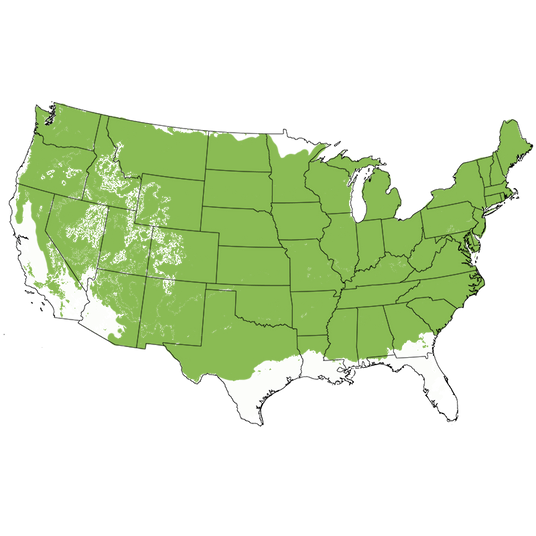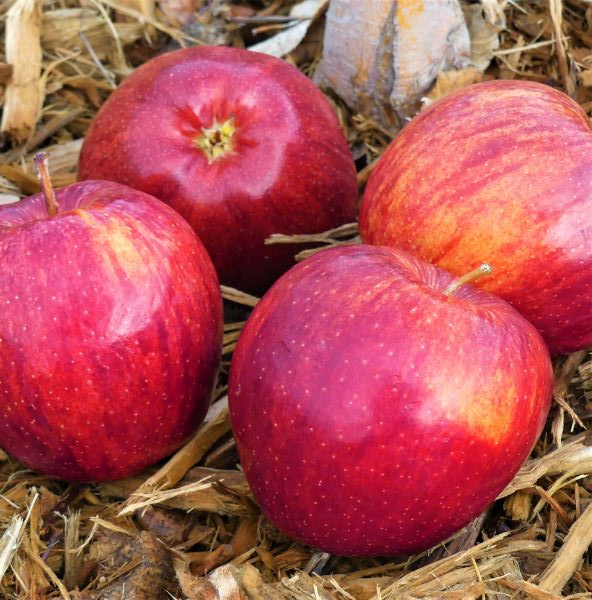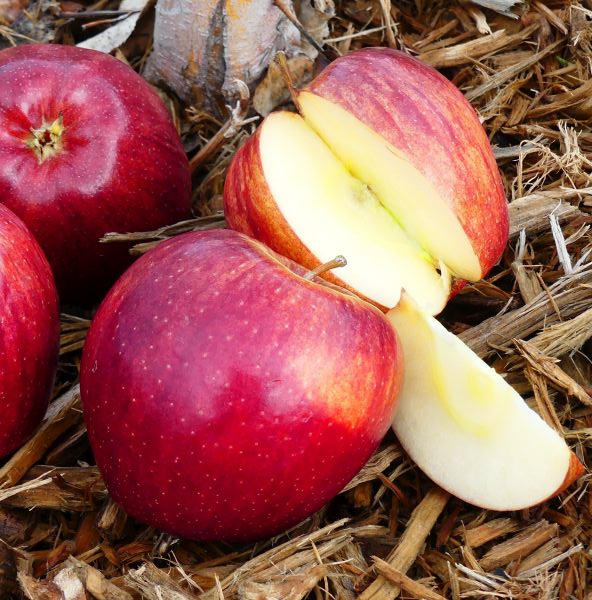Cameo Apple Tree
Malus 'Cameo'
Plant Sentry™
Plant Sentry™

Plant Sentry™ Protected
Your order is protected by our compliance system that:
- Prevents restricted plants from shipping to your state
- Ensures plants meet your state's agricultural requirements
- Protects gardens from invasive pests and diseases
Delivery and Shipping
Delivery and Shipping
Delivery and Shipping
Fast, Safe Plant Delivery
Ships in 3-4 business days • Tracking provided • Weather protected
| Under $50 | $9.99 |
| $50 - $99.99 | $14.99 |
| $100 - $149.99 | $16.99 |
| $150 - $198.99 | $24.99 |
| $199+ | FREE |
✓ Zone-specific timing • ✓ Professional packaging • ✓ Health guarantee
Understanding Plant Options
Nature Hills offers plants in two main formats:
- Container Plants: Grown in pots with soil, sized by container volume and plant age
- Bare Root Plants: Dormant plants without soil, sized by height measurements
Container Plant Sizes
Container sizes indicate plant age and growing capacity rather than liquid volume equivalents. Our containers follow industry-standard nursery "trade gallon" specifications, which differ from standard liquid gallon measurements.
Young Plants (6 months to 18 months old)
| Container Size | Actual Volume | Metric Equivalent |
|---|---|---|
| 2" x 2" x 3" | 0.18 - 0.21 dry quarts | 0.20 - 0.23 dry liters |
| 4" Container | 0.31 - 0.87 dry quarts | 0.35 - 0.96 dry liters |
| 4.5" Container | 0.65 dry quarts | 0.72 dry liters |
| 6" Container | 1.4 dry quarts | 1.59 dry liters |
| 1 Quart | 1 dry quart | 1.1 dry liters |
| 5.5" Container | 1.89 dry quarts | 2.08 dry liters |
Established Plants (18 months to 2.5 years old)
| Container Size | Actual Volume | Metric Equivalent |
|---|---|---|
| 2 Quart | 2 dry quarts | 2.2 dry liters |
| #1 Container | 2.26 - 3.73 dry quarts | 2.49 - 4.11 dry liters |
| 5" x 5" x 12" | 3.5 - 4.3 dry quarts | 3.85 - 4.74 dry liters |
Mature Plants (2-4 years old)
| Container Size | Actual Volume | Metric Equivalent |
|---|---|---|
| #2 Container | 1.19 - 1.76 dry gallons | 5.24 - 7.75 dry liters |
| #3 Container | 2.15 - 2.76 dry gallons | 8.14 - 12.16 dry liters |
Large Plants (3-5 years old)
| Container Size | Actual Volume | Metric Equivalent |
|---|---|---|
| #5 Container | 2.92 - 4.62 dry gallons | 12.86 - 20.35 dry liters |
| #6 Container | 5.25 - 6.01 dry gallons | 23.12 - 26.42 dry liters |
| #7 Container | 5.98 - 6.53 dry gallons | 26.34 - 28.76 dry liters |
Bare Root Plants
Bare root plants are sold by height from the root system to the top of the plant. Plants may exceed minimum height requirements.
Common Sizes:
- Trees: 1 foot, 2 feet, 3 feet, 4 feet, 5 feet, 6 feet
- Shrubs & Perennials: 1 foot, 18 inches, 2 feet
Important Notes
Container Volume Specifications
- Trade Gallon Standard: Our containers follow industry-standard "trade gallon" specifications established by the American National Standards Institute (ANSI Z60.1) for nursery stock
- Volume Variations: Actual soil volume may vary due to plant root systems and growing medium settlement
- Age Indicators: Container size primarily indicates plant age and maturity rather than liquid volume equivalents
Growing Conditions
- Plant size can vary based on variety and growing conditions
- Container size helps indicate plant maturity and establishment level
- Larger containers generally mean more established root systems and faster landscape establishment
Seasonal Availability
- Bare root plants are available seasonally when dormant
- Container plants are available throughout the growing season
- Specific varieties may have limited availability in certain sizes
Questions?
For questions about specific plant sizes or availability, please contact our plant experts who can help you choose the right size for your landscape needs.

Plant Sentry™ Protected
Your order is protected by our compliance system that:
- Prevents restricted plants from shipping to your state
- Ensures plants meet your state's agricultural requirements
- Protects gardens from invasive pests and diseases
Plant Profile & Growing Essentials
Cold hardy, Flowering, Edible, Ornamental Berries/Fruit, and Attracts pollinators
Specifications
Specifications
-
Botanical Name
-
Height
-
Width
-
Growing Zones
-
Sunlight
-
Growth RateModerate
-
Flower Color
-
Leaf Color
-
Fall Color
-
Pollinator FriendlyYes
-
Pollinator Required
-
FragrantYes
-
Bloom PeriodLate Spring
Planting & Care Instructions
Planting & Care Instructions
Cameo Apple Tree - Sliced Fruit Resists Browning
- Mid-Season Harvest
- 600 Chill Hours
- Very Cold Hardy
- Long Harvest Time & Good Keeping Apple!
- Perfect Balance Between Sweet and Tart
- Firm & Crisp, Zingy Flavor
- Prized by Chefs and Foodies
- Fresh Eating & Great for Cut Fruit Salads, Resists Browning
- Blend With Other Varieties in Pies, Cobblers & Crisps
- Thin-Skinned Yellow-Green Undertones & Prominent Red Stripes
- Lush Green Foliage & Yellow Fall Color
- Beneficial Pollinators Appreciate Lovely White Fragrant Blooms!
- Pollinated by Gala, Fuji, Braeburn & Pink Lady
Chefs love homegrown, pretty Cameo apples for cheese plates, salads & pies. Grow your own Cameo Apple tree! This rewarding adventure ensures a fresh supply of fresh, brown-resistant fruit!
Formerly known as the Carousel Apple, the Cameo Apple Tree (Malus 'Cameo') has earned rave reviews from both growers and consumers! Vigorous growth and ornamental beauty, this is a versatile and adaptable fruit tree!
Cameo is prized for its thin skin with a crisp, sweet, tangy and juicy texture. They are described as having the perfect balance in taste between sweet and tart. Plus these healthy snacks are very high in antioxidants!
The crisp and zingy texture makes them perfect fresh off the tree, in salads and preserves as they are blended with other apple varieties in your favorite baked goods because it holds their shape well in baked goods.
The resistance to browning when cut makes them very popular in salads and sandwiches. Include crisp and juicy Cameo slices on cheese plates for an effortlessly chic dessert.
The spring trees have lovely white flowers that are fragrant and draw admiration from you and your pollinators!
Cameo fruit is medium to large and uniform in size. Featuring distinctive bright red striping over a yellow and light-green under color. The creamy white-yellow flesh is crisp and juicy and you'll love the aroma of a freshly cut Cameo!
How to Use Cameo Apple Tree In The Landscape
There’s nothing quite as charming as a blooming apple tree in the garden! Sit beneath the shade and dream of the harvest, or picnic beneath the spring blooms and watch the bees lazily buzz about.
Cottage gardens look idyllic, and your perennial and vegetable gardens gain some shade from these lovely trees.
Plant one by your patio for ornamental accent or outside your picture window so you can easily view the glorious spring, summer and autumn display! With a touch of yellow fall color and wonderful branching, Apple trees are gorgeous specimens year-round.
Shade your patio or add a row along your property for gorgeous definition.
The prolific blooms alone make Cameo a fantastic specimen plant. The smaller sized trees are front garden specimens and side yard accent trees!
Standard-sized trees are fantastic for back garden shade and ornamentals, and both sizes fit perfectly into any sized orchard!
This variety is widely heralded as one of the most flavorful, crispy, and juicy apples anywhere. The Cameo matures one week before Fuji and has a long harvest and storage window. Ripening in September to October, your fall desserts will also receive rave reviews!
#ProPlantTips For Care
One of the easiest to grow apples, Cameo is hardy in growing zones 4-8, giving them excellent cold and heat tolerance. A chance seedling that is a cross between the classic Red Delicious and Golden Delicious Apple trees.
All Apples need full sun for the best crops, especially the morning sun to dry the dew from the foliage.
Plant in organically rich soil that is well-drained for best results. A good layer of mulch over the root system keeps them cool, moist and insulated!
Requiring consistent access to moisture, be sure to set up a regular watering cycle to protect your investment and have the juiciest crop.
Prune when dormant in late winter to open the canopy and provide air circulation. You can also train your tree smaller or into Espalier for a custom-sized tree for your needs!
Cameo apples are hard to find in grocery stores. These trees never stay in stock long. Buy yours today and have your own fresh-off-the-tree healthy fruit for you and your family!
Call Nature Hills today!
Cameo Apple Tree Frequently Asked Questions
When to Plant Cameo Apple Trees
Planting Bareroot trees as soon as you can dig a hole in spring and until hot weather, the earlier the better. Plant container Apple trees throughout the growing season with complete success - that is the benefit of container plants - to extend the planting season. Your County Agricultural Extension Office is a great resource for first and last frost dates in your area.
How to Plant Cameo Apple Trees
Dig a large hole only as deep as needed to accommodate the bareroot or container root ball, and twice as wide. Add Nature Hills Root Booster to speed root establishment. Remove the pot or bag and situate it into the hole so the top of the soil (soil line if bareroot), is level with the new location's soil being careful not to plant too deep. Water in again very well and backfill with the same soil you dug up, tamping down gently to ensure there are no air pockets.
Top off with a 3-4 inch thick layer of Arborist mulch. Consider staking your tree to keep its trunk growing straight for the first year to ensure it stands tall against strong winds and drifting snow.
When to Prune Cameo Apple Trees
Trim off any broken branches from delivery as soon as you take them out of the box. Prune and trim apple trees while dormant, in late winter or early spring, before you see new growth.
How to Prune Cameo Apple Trees
Dormant prune to:
- Remove any double leaders or narrow crotch angles
- Eliminate any crossing branches
- Thin interior branching and leave the fruiting spurs and strong branches in place opening up the canopy
- Branching at least 24-36 inches above the ground
Prune Apple trees in the summer to:
- Control size and shape by reducing the length of longer new growth on vigorous trees
- Remove water sprouts on the main trunk or older branches in the crown
- Remove suckers at the base of the trunk
- Thin fruit during heavy years on established trees
How to Care for Cameo Apple Trees
Growing an apple tree is easy when proper soil, good drainage, attention to moisture, and regular fertility are maintained. Once you've chosen an apple tree that works for your climate, in the size you need for your landscape, and its pollinator (if needed), then you've accomplished half the battle!
- Apple trees do best in full sun and well-drained soil
- Water your apple trees when it gets dry - especially during the fruit production stage, and drought periods to keep it stress-free
- Use arborists' wood chips to mulch over the roots of your apples and have your soil tested to see what your soil may be lacking before adding fertilizers
- Maintenance pruning and shaping
Apple trees will tolerate a wide range of soils, so long as water and nutrients are not limited and the pH level is adequate.
How to Fertilize Cameo Apple Trees
For the first year, water alone is most important. It is always best to get a soil test to see what your soil is lacking before adding more fertilizers. Once established, a fertilizer routine may be beneficial. We do offer some excellent slow-release organic options, applied according to the package directions.
Fruit trees need more phosphate and it's possible to apply too much nitrogen which affects the soil's pH. Test soil acidity or alkalinity using a pH Tester.
Fertilize in spring when you first see new growth emerging.
- Don't overdo it
- Phosphates are your friends
- Pay attention to pH in areas with extremely high or low soil pH
- Follow the directions
Cameo Apple Tree Pollinating Info
Cameo is not self-fruiting and needs a pollinating partner. Pair with one of these varieties:
Harvest Times for Cameo Apple Trees
Cameo’s are typically ready to harvest in October.
Early-Season? Mid-Season? Late-Season? The terminology can be confusing for new apple tree growers. Weather, climate and your tree determine when it's ripe.
For Apples:
- Early-season is usually June-July
- Mid-season can be August-September
- Late-season can be from late September-November
The growing season consists of spring, summer, and fall, and varies with climate and weather. Areas with longer growing seasons in the warmer hardiness zones can greatly affect the harvest times for each particular apple variety grown in your area. Learn which growing zone you are in.
What Shipping Options Do You Offer?
NatureHills.com works closely with our growers and nursery professionals to ensure we ship when it is most appropriate for your area. Our goal is to deliver the hardiest plants by avoiding extreme high and low temperatures. Check out our shipping schedule for more information and to learn our wills and won'ts when it comes to shipping plants. Find your Cameo Apple Tree for sale here at NatureHills.com!
Rootstocks Explained
Apple trees have been grafted onto different rootstocks since before the mid-1800s. Different rootstocks are used to improve the anchoring of trees, eliminate diseases, and reduce the natural mature size of the tree itself. While there are many different types of rootstock, they are all labeled as being either Dwarf, Semi-Dwarf, or Standard.
The apple descriptions, including flowering, pollination, and apple characteristics are the same whether the plant is grown on a standard rootstock or some varying dwarfing rootstock. The overall size can vary by climate and soil but the understock used is ultimately what affects the mature size.
There will be some variation in sizes but as a guide, we are suggesting the overall mature size of these apple varieties are:
Semi-Dwarf Apples
- Height: 12-18 feet
- Spread: 10 - 15 feet
Standard Apples
- Height 18 - 25 feet
- Spread: 15 - 18 feet
Remember that all fruit tree sizes can easily be altered if needed by simple pruning as the trees grow and develop.











